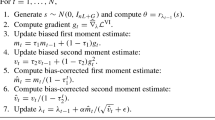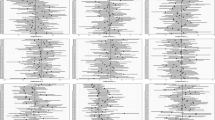Abstract
We show that the choice of posterior approximation affects the solution found in Bayesian variational learning of linear independent component analysis models. Assuming the sources to be independent a posteriori favours a solution which has orthogonal mixing vectors. Linear mixing models with either temporally correlated sources or non-Gaussian source models are considered but the analysis extends to nonlinear mixtures as well.
Similar content being viewed by others
Abbreviations
- ICA:
-
Independent component analysis
- MoG:
-
Mixture of Gaussians
- PCA:
-
Principal component analysis
References
H. Attias (1999) ArticleTitleIndependent factor analysis Neural Computation 11 IssueID4 803–851 Occurrence Handle10.1162/089976699300016458 Occurrence Handle10226184
Lappalainen, H.: Ensemble learning for independent component analysis, In: Proceedings of Int. Workshop on Independent Component Analysis and Signal Separation (ICA99), pp. 7–12, Aussois: France, 1999.
Miskin, J. and MacKay, D. J. C.: Ensemble learning for blind source separation, In: S. Roberts and R. Everson (eds.),Independent Component Analysis: Principles and Practice, pp. 209–233, Cambridge University Press, 2001.
Choudrey, R., Penny, W. and Roberts, S.: An ensemble learning approach to independent component analysis, In: Proceeding of the IEEE Workshop on Neural Networks for Signal Processing, pp. 435–444, IEEE Press: Sydney, Australia, 2000.
Valpola, H.: Nonlinear independent component analysis using ensemble learning: theory, In: Proceeding of International Workshop on Independent Component Analysis and Blind Signal Separation (ICA2000), pp. 251–256, Helsinki, Finland, 2000.
K. Chan T. Lee T. J. Sejnowski (2002) ArticleTitleVariational learning of clusters of undercomplete nonsymmetric independent components Journal of Machine Learning Research 3 99–114 Occurrence Handle10.1162/153244303768966120 Occurrence HandleMR1966055
K. Chan T. Lee T. J. Sejnowski (2003) ArticleTitleVariational bayesian learning of ICA with missing data Neural Computation 15 IssueID8 1991–2011 Occurrence Handle10.1162/08997660360675116
H. Valpola J. Karhunen (2002) ArticleTitleAn unsupervised ensemble learning method for nonlinear dynamic state-space models Neural computation 14 IssueID11 2647–2692 Occurrence Handle10.1162/089976602760408017
Ilin, A. and Valpola, H.: On the effect of the form of the posterior approximation in variational learning of ICA models, In: Proceeding of the 4th International Conference on Independent Component Analysis and Blind Signal Separation (ICA2003), pp. 915–920, Nara: Japan, 2003.
Barber, D. and Bishop, C. Ensemble learning for multi-layer networks, In: M. Jordan, M. Kearns and S. Solla (eds.), Advances in Neural Information Processing Systems 10, pp. 395–401, The MIT Press: Cambridge, MA, USA.
Z. Ghahramani G. E. Hinton (2000) ArticleTitleVariational learning for switching state-space models Neural computation 12 IssueID4 963–996 Occurrence Handle10.1162/089976600300015619
Hyvärinen, A., Karhunen, J. and Oja, E.: Independent Component Analysis, Wiley, 2001.
A. Belouchrani K. A. Meraim J.-F. Cardoso E. Moulines (1997) ArticleTitleA blind source separation technique based on second order statistics IEEE Trans. on Signal Processing 45 IssueID2 434–444 Occurrence Handle10.1109/78.554307
Ziehe, A., Müller, K.-R., Nolte, G., Mackert, B.-M. and Cuiro, G.: Artifact reduction in manetoneurography based on time-delayed second order correlations, Technical Report 31, GMD–Forschungszentrum Informationstechnik GmbH, 1998.
Tong, L., Soo, V., Liu, R. and Huang, Y.: Amuse: a new blind identification algorithm, In: Proceedings ISCAS, New Orleans, USA, 1990.
Z. Ghahramani M. Beal (2001) Propagation algorithms for variational Bayesian learning T. Leen T. Dietterich V. Tresp (Eds) Advances in Neural Information Processing Systems 13 The MIT Press Cambridge, MA, USA 507–513
Valpola, H., Honkela, A., Harva, M., Ilin, A., Raiko, T. and Östman, T.: Bayes blocks software library, http://www.cis.hut.fi/projects/bayes/sofware/, 2003.
Valpola, H., Raiko, T. and Karhunen, J.: Building blocks for hierarchical latent variable models, In: Proceedings of the 3rd International Conference on Independent Component Analysis and Signal Separation (ICA2001), pp. 710–715, San Diego, USA, 2001.
Ilin A.: Matlab code for variational bayesian learning of linear ICA models, http://www.cis.hut.fi/projects/bayes/sofware/np12004/, 2004.
H. Valpola M. Harva J. Karhunen (2004) ArticleTitleHierarchical models of variance sources Signal Processing 84 IssueID2 267–282 Occurrence Handle10.1016/j.sigpro.2003.10.014
M. Harva (2004) Hierarchical variance models of image sequences Helsinki University of Technology Espoo
P. A. d. F. R. Højen-Sørensen O. Winter L. K. Hansen (2002) ArticleTitleMean-field approaches to independent component analysis Neural Computation 14 IssueID4 889–918 Occurrence Handle10.1162/089976602317319009 Occurrence Handle11936966
Author information
Authors and Affiliations
Corresponding author
Rights and permissions
About this article
Cite this article
Ilin, A., Valpola, H. On the Effect of the Form of the Posterior Approximation in Variational Learning of ICA Models. Neural Process Lett 22, 183–204 (2005). https://doi.org/10.1007/s11063-005-5265-0
Issue Date:
DOI: https://doi.org/10.1007/s11063-005-5265-0




